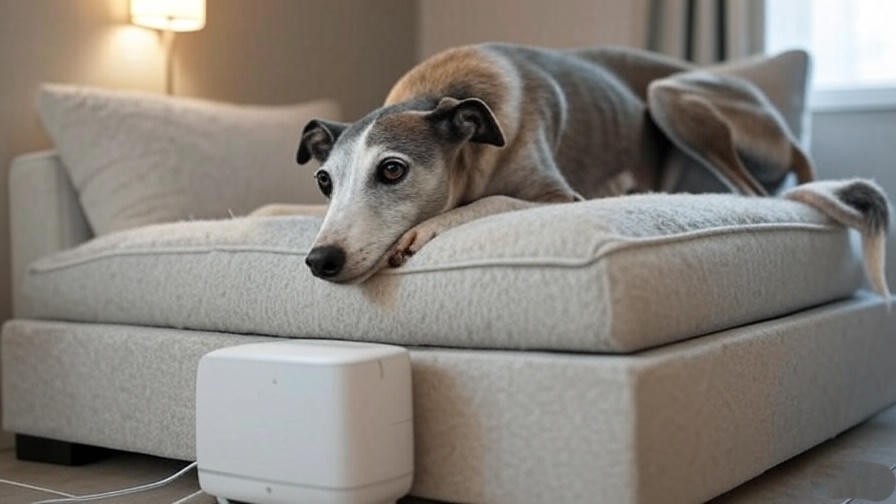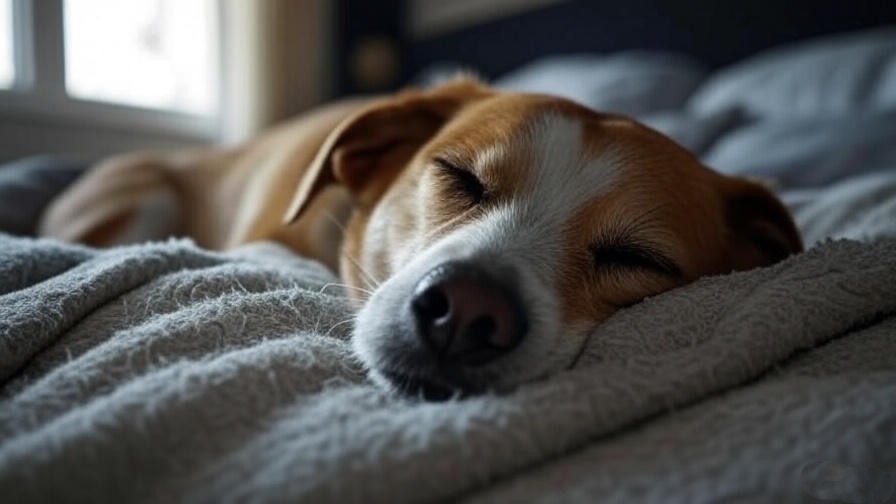It’s 2 a.m., and the house is quiet except for one sound: your dog’s heavy breathing echoing from their bed. As a devoted pet owner, you can’t help but wonder, “Is my dog breathing heavy while sleeping because of a problem, or is this just normal?” This common concern keeps many pet parents awake, questioning whether their furry friend is simply dreaming or signaling a health issue. Heavy breathing during sleep can stem from harmless quirks like vivid dreams or serious conditions requiring veterinary attention. In this comprehensive guide, we’ll explore the causes of heavy dog breathing during sleep, when to worry, and actionable solutions to ensure your pet’s health and your peace of mind. Backed by insights from veterinarians and pet sleep experts, this article will empower you to understand and address your dog’s breathing patterns effectively.
Understanding Normal Dog Breathing During Sleep

What Does Normal Dog Breathing Look Like?
When your dog is asleep, their breathing should typically be steady, rhythmic, and quiet, with occasional soft sighs or gentle snores. According to Dr. Emily Carter, a veterinarian with over 15 years of experience, “Normal breathing in a sleeping dog is calm, with 15–30 breaths per minute, depending on their size and breed.” Smaller dogs, like Chihuahuas, tend to breathe faster, while larger breeds, like Great Danes, may have slower, deeper breaths. Brachycephalic breeds—those with short snouts, such as bulldogs or pugs—often have naturally noisier breathing due to their airway structure.
To assess your dog’s breathing, observe them in a relaxed state. Look for consistent chest movements and listen for sounds like soft whistling or light snoring, which are often normal. Environmental factors, like a warm room or a stuffy nose from dust, can slightly alter breathing patterns without cause for alarm.
Tip: To familiarize yourself with your dog’s baseline, spend a few minutes watching them sleep in a cool, quiet environment. Note their breathing rate and any sounds to establish what’s normal for them.
Why Do Dogs Breathe Heavily While Sleeping?
Heavy breathing during sleep can often be attributed to natural, non-threatening causes. One common reason is the REM (rapid eye movement) sleep phase, where dogs dream vividly. During REM sleep, your dog’s brain is active, processing daily experiences, which can lead to faster or irregular breathing, twitching, or even vocalizations like whimpers. Puppies and senior dogs tend to have more intense REM cycles, which may amplify these behaviors.
Other benign factors include physical exertion before bedtime (e.g., a long walk or play session), which can cause temporary heavy breathing as their body recovers. Environmental conditions, such as a warm room or poor ventilation, can also make breathing seem heavier. For instance, a dog sleeping in a stuffy room may pant lightly or breathe more audibly to regulate their body temperature.
Tip: To distinguish normal heavy breathing from concerning patterns, check if it subsides within 10–15 minutes of your dog falling asleep. Persistent or labored breathing warrants closer attention.
Common Benign Causes of Heavy Breathing in Sleeping Dogs
Dreaming and REM Sleep
Just like humans, dogs experience dreams during REM sleep, which occurs in cycles throughout the night. Studies from the American Kennel Club suggest that dogs dream more frequently than humans, with small breeds and puppies dreaming every 10–20 minutes during sleep. During these dreams, your dog might “run” in their sleep, twitch their paws, or breathe heavily as their brain replays exciting moments, like chasing a squirrel.
For example, Sarah, a pet owner from Seattle, noticed her Labrador, Max, breathing heavily and making soft barking noises while sleeping. “I thought something was wrong, but my vet explained Max was just dreaming about his morning fetch game,” she shared. This is a classic sign of REM-related heavy breathing, which typically resolves as the dream cycle ends.
Tip: Avoid waking your dog during a dream, as this can startle them. Let the cycle pass naturally, and monitor if heavy breathing persists beyond a few minutes.
Environmental and Lifestyle Factors
Your dog’s sleep environment plays a significant role in their breathing patterns. A room that’s too warm (above 75°F) can cause panting or heavier breathing as your dog tries to cool down. Poor air quality, such as dust or pollen in the home, may irritate their airways, leading to temporary snoring or labored breathing. Sleeping position also matters—dogs lying on their side or stomach may breathe more heavily due to pressure on their diaphragm.
To optimize your dog’s sleep environment:
- Keep the room cool (ideally 65–70°F).
- Use an air purifier to reduce allergens.
- Provide a supportive bed that allows your dog to stretch comfortably.
Example: A pet owner reported that switching to a cooling gel mat for their Golden Retriever reduced nighttime heavy breathing caused by overheating.
Breed-Specific Breathing Patterns
Certain breeds are predisposed to heavier breathing due to their anatomy. Brachycephalic breeds, such as French Bulldogs, Pugs, and Boston Terriers, have short nasal passages and elongated soft palates, which can restrict airflow and cause snoring or heavy breathing during sleep. Dr. Rachel Lee, a veterinary specialist in respiratory health, explains, “Brachycephalic dogs often sound like they’re struggling to breathe, but this is normal for their anatomy unless accompanied by distress.”
Common Brachycephalic Breeds Prone to Heavy Breathing:
- Pug
- French Bulldog
- Bulldog
- Shih Tzu
- Boxer
If you own one of these breeds, heavy breathing during sleep may be less concerning but should still be monitored for changes in frequency or intensity.
Tip: Regularly clean your brachycephalic dog’s facial folds to prevent infections that could worsen breathing issues.
When to Worry: Medical Causes of Heavy Breathing

Respiratory Issues
Heavy breathing that persists or is accompanied by other symptoms may indicate a respiratory problem. Conditions like kennel cough, allergies, or pneumonia can cause labored breathing, even during sleep. Kennel cough, for instance, often presents with a honking cough and nasal discharge, while allergies may cause wheezing or snuffling sounds.
Symptoms to Watch For:
- Persistent coughing or gagging
- Nasal discharge (clear, yellow, or green)
- Wheezing or whistling sounds
- Reduced energy or appetite
Example: Bella, a 5-year-old Beagle, began breathing heavily at night, accompanied by a dry cough. Her owner took her to the vet, where she was diagnosed with kennel cough and treated with antibiotics, resolving the issue within two weeks.
Tip: If you notice respiratory symptoms, isolate your dog from other pets to prevent spreading infections like kennel cough and consult a vet promptly.
Heart and Lung Conditions
Serious conditions like congestive heart failure or pulmonary edema (fluid in the lungs) can manifest as heavy breathing during sleep. These issues are more common in older dogs or breeds prone to heart disease, such as Cavalier King Charles Spaniels or Dobermans. According to the American Veterinary Medical Association, heart disease affects approximately 10% of dogs, with symptoms often worsening at night when the body is at rest.
Red Flags Requiring Immediate Veterinary Attention:
- Blue or pale gums
- Rapid, shallow breathing that doesn’t subside
- Lethargy or weakness
- Fainting or collapse
Tip: If your dog shows any of these signs, seek emergency veterinary care immediately, as they may indicate a life-threatening condition.
Obesity and Physical Health
Excess weight can put significant strain on a dog’s respiratory system, leading to heavy breathing during sleep. The Association for Pet Obesity Prevention reports that over 50% of dogs in the U.S. are overweight or obese, increasing the risk of breathing difficulties. Extra fat around the chest and abdomen can restrict lung expansion, making breathing more labored.
Actionable Steps for Weight Management:
- Consult your vet for a tailored diet plan.
- Feed high-quality, low-calorie food in controlled portions.
- Incorporate daily exercise, like 20–30 minute walks, adjusted for your dog’s fitness level.
Example: A case study of a Dachshund named Milo showed that losing 5 pounds through diet and exercise reduced his nighttime snoring and improved his energy levels.
Tip: Use a body condition score chart (available from most veterinary websites) to assess whether your dog is at a healthy weight.
Pain or Discomfort
Undiagnosed pain, such as from arthritis, dental issues, or injuries, can cause irregular breathing patterns during sleep. Dogs in pain may breathe heavily due to stress or difficulty finding a comfortable position. Senior dogs are particularly prone to arthritis, which affects over 20% of dogs over age 7, according to veterinary studies.
Signs of Pain to Check For:
- Reluctance to move or lie down
- Whining or restlessness during sleep
- Limping or stiffness after waking
Tip: Gently palpate your dog’s joints or limbs during waking hours to check for sensitivity, and note any behavioral changes to discuss with your vet.
Diagnosing the Issue: When and How to Seek Veterinary Help
Signs It’s Time to See a Vet
While occasional heavy breathing may be normal, persistent or severe symptoms require professional evaluation. Use this checklist to determine if a vet visit is necessary:
- Heavy breathing lasts more than 15 minutes per sleep session.
- Breathing is accompanied by coughing, wheezing, or choking sounds.
- Your dog seems distressed, restless, or unable to settle.
- Other symptoms like lethargy, loss of appetite, or pale gums are present.
Downloadable Resource: Create a “Dog Breathing Health Checklist” (available for download on the website) to help pet owners track symptoms and share them with their vet.
What to Expect at the Vet
A veterinarian will begin with a thorough physical exam, listening to your dog’s heart and lungs with a stethoscope. Depending on symptoms, they may recommend:
- X-rays to check for lung or heart abnormalities.
- Blood tests to detect infections or organ dysfunction.
- Sleep monitoring or pulse oximetry to measure oxygen levels.
Dr. Carter notes, “Modern diagnostics, like thoracic X-rays, can pinpoint issues like airway obstructions or heart enlargement in under an hour, giving us clear answers.”
Questions to Ask Your Vet
To ensure you leave the appointment with clarity, ask:
- Is my dog’s breathing issue related to their breed or age?
- What tests do you recommend, and why?
- Are there lifestyle changes that could improve my dog’s breathing?
- Could this be a chronic condition requiring ongoing management?
Tip: Write down your observations (e.g., frequency of heavy breathing, time of day) before the visit to provide your vet with detailed information.
Solutions and Management for Heavy Breathing
At-Home Remedies for Benign Causes
For heavy breathing caused by benign factors like environmental conditions or REM sleep, simple adjustments can make a significant difference. Here are practical steps to improve your dog’s sleep quality:
- Optimize Room Temperature: Keep your dog’s sleeping area between 65–70°F to prevent overheating. Use a fan or air conditioning in warmer climates to promote comfortable breathing.
- Improve Air Quality: Use a HEPA air purifier to reduce dust, pollen, and other allergens that may irritate your dog’s airways. Regularly clean bedding to minimize dust buildup.
- Adjust Sleeping Position: Provide a supportive bed that allows your dog to lie flat, reducing pressure on their chest. Orthopedic foam beds are ideal for older dogs or those with joint issues.
- Hydration: Ensure your dog has access to fresh water before bed, as dehydration can cause dry airways and heavier breathing.
Step-by-Step Guide to Creating a Pet-Friendly Sleep Environment:
- Choose a quiet, low-traffic area for your dog’s bed.
- Place a cooling mat or breathable bedding on top of their bed.
- Use a white noise machine to drown out household sounds that might disrupt sleep.
- Check the room’s ventilation and open a window if safe and appropriate.
Example: Lisa, a pet owner from Chicago, noticed her Cocker Spaniel’s heavy breathing reduced after switching to a cooling mat and running an air purifier at night. “It was such a simple fix, but it made a huge difference,” she said.
Medical Treatments
If heavy breathing is linked to a medical issue, your veterinarian may recommend specific treatments based on the diagnosis. Common interventions include:
- Medications: Antibiotics for respiratory infections like kennel cough, antihistamines for allergies, or bronchodilators for asthma-like conditions.
- Oxygen Therapy: For severe cases, such as pulmonary edema, short-term oxygen therapy may stabilize breathing.
- Surgery: Brachycephalic breeds with severe airway obstructions may benefit from procedures like soft palate resection to improve airflow.
Success Story: Max, a 7-year-old Bulldog, struggled with heavy breathing due to brachycephalic airway syndrome. After a vet-recommended surgery to widen his airways, his nighttime breathing became quieter, and he slept more comfortably.
Tip: Follow your vet’s instructions precisely for medications, and schedule follow-up visits to monitor progress. Never administer human medications to your dog without veterinary guidance.
Lifestyle Changes for Long-Term Health
Long-term management of heavy breathing often involves lifestyle adjustments to support your dog’s overall health. Key strategies include:
- Weight Management: If your dog is overweight, work with your vet to create a diet plan. Switch to a high-quality, low-calorie dog food and measure portions carefully. Aim for gradual weight loss (1–2% of body weight per week).
- Exercise Routine: Incorporate daily exercise tailored to your dog’s fitness level. For example:
- Overweight Dogs: Start with 10–15 minute walks twice daily, gradually increasing duration.
- Senior Dogs: Try low-impact activities like swimming or short strolls.
- Puppies: Provide structured playtime to burn energy without overexertion.
- Stress Reduction: Anxiety can exacerbate heavy breathing. Use calming techniques like gentle petting, pheromone diffusers, or calming supplements (consult your vet first).
Sample Exercise Plan for an Overweight Dog:
- Week 1–2: Two 10-minute walks daily, plus 5 minutes of indoor fetch.
- Week 3–4: Increase to 15-minute walks and add a 10-minute play session.
- Ongoing: Aim for 30–60 minutes of activity daily, adjusted for your dog’s breed and health.
Tip: Incorporate holistic practices, such as a 5-minute calming massage before bed, to reduce stress and promote relaxed breathing.
Preventive Measures to Support Healthy Sleep

Optimizing Your Dog’s Sleep Environment
A well-designed sleep environment can prevent heavy breathing and promote restful sleep. Consider these elements:
- Comfortable Bedding: Choose an orthopedic or memory foam bed for joint support, especially for senior dogs or breeds prone to arthritis.
- Quiet Space: Place your dog’s bed in a low-traffic area away from loud appliances or busy household zones.
- Temperature Control: Maintain a cool, well-ventilated room to prevent overheating, which can worsen breathing issues.
Recommended Products:
- Orthopedic Dog Bed: PetFusion Ultimate Dog Bed for joint support.
- Cooling Mat: The Green Pet Shop Cooling Mat for temperature regulation.
- Air Purifier: Levoit Core 300 for allergen reduction.
Tip: Wash bedding weekly and vacuum the sleep area to keep it free of dust and dander.
Regular Health Checkups
Routine veterinary visits are essential for catching potential issues before they escalate. The American Veterinary Medical Association recommends annual checkups for adult dogs and biannual visits for seniors (over 7 years). During these visits, your vet can assess your dog’s respiratory and heart health, ensuring early detection of conditions like heart disease or allergies.
Tip: Keep a health journal to track your dog’s breathing patterns, appetite, and energy levels. Share this with your vet to aid in early diagnosis.
Stress Reduction and Holistic Well-Being
As a website focused on holistic well-being, we recognize the connection between mental calm and physical health. Stress can contribute to heavy breathing by increasing heart rate and muscle tension. Incorporate these calming techniques into your dog’s routine:
- Gentle Petting: Spend 5–10 minutes stroking your dog slowly before bed to lower their stress levels.
- White Noise: Use a white noise machine or calming music designed for dogs to create a soothing atmosphere.
- Calming Supplements: Ask your vet about supplements like L-theanine or chamomile, which may reduce anxiety-related breathing issues.
Holistic Practice: Try a mindfulness-inspired routine by sitting with your dog in a quiet space, breathing slowly together to promote relaxation. This can be especially helpful for anxious dogs or those recovering from stressful events.
Tip: Explore our related article, “Holistic Ways to Reduce Pet Anxiety,” for more strategies to enhance your dog’s emotional well-being.
FAQs About Dog Breathing Heavy While Sleeping

Q1: Is it normal for my dog to breathe heavily while dreaming?
A: Yes, heavy breathing during dreams is common, especially during REM sleep. It’s typically harmless unless it persists beyond a few minutes or is accompanied by distress.
Q2: How can I tell if my dog’s heavy breathing is a medical emergency?
A: Look for red flags like blue gums, rapid shallow breathing, lethargy, or collapse. These require immediate veterinary attention.
Q3: Can certain breeds be more prone to heavy breathing during sleep?
A: Yes, brachycephalic breeds like Pugs, Bulldogs, and French Bulldogs often breathe heavily due to their airway structure. Monitor for worsening symptoms.
Q4: What home remedies can help my dog breathe easier at night?
A: Improve air quality with a purifier, maintain a cool room, and use supportive bedding. Always consult a vet if symptoms persist.
Q5: When should I consult a vet about my dog’s breathing?
A: Schedule a visit if heavy breathing lasts more than 15 minutes per sleep session, occurs frequently, or is paired with symptoms like coughing or lethargy.
Conclusion
Heavy breathing in a sleeping dog can range from a quirky sign of a vivid dream to a signal of an underlying health issue. By understanding normal breathing patterns, recognizing benign causes like REM sleep or environmental factors, and knowing when to seek veterinary help, you can ensure your dog’s health and enjoy peaceful nights together. Start by observing your dog’s breathing, optimizing their sleep environment, and scheduling regular vet checkups. If you notice persistent or concerning symptoms, don’t hesitate to consult a professional. Your bond with your pet is special—taking these steps strengthens it by prioritizing their well-being.













